The Use of Refuges by Communally Housed Cats
Abstract
:Simple Summary
Abstract
1. Introduction
2. Materials and Methods
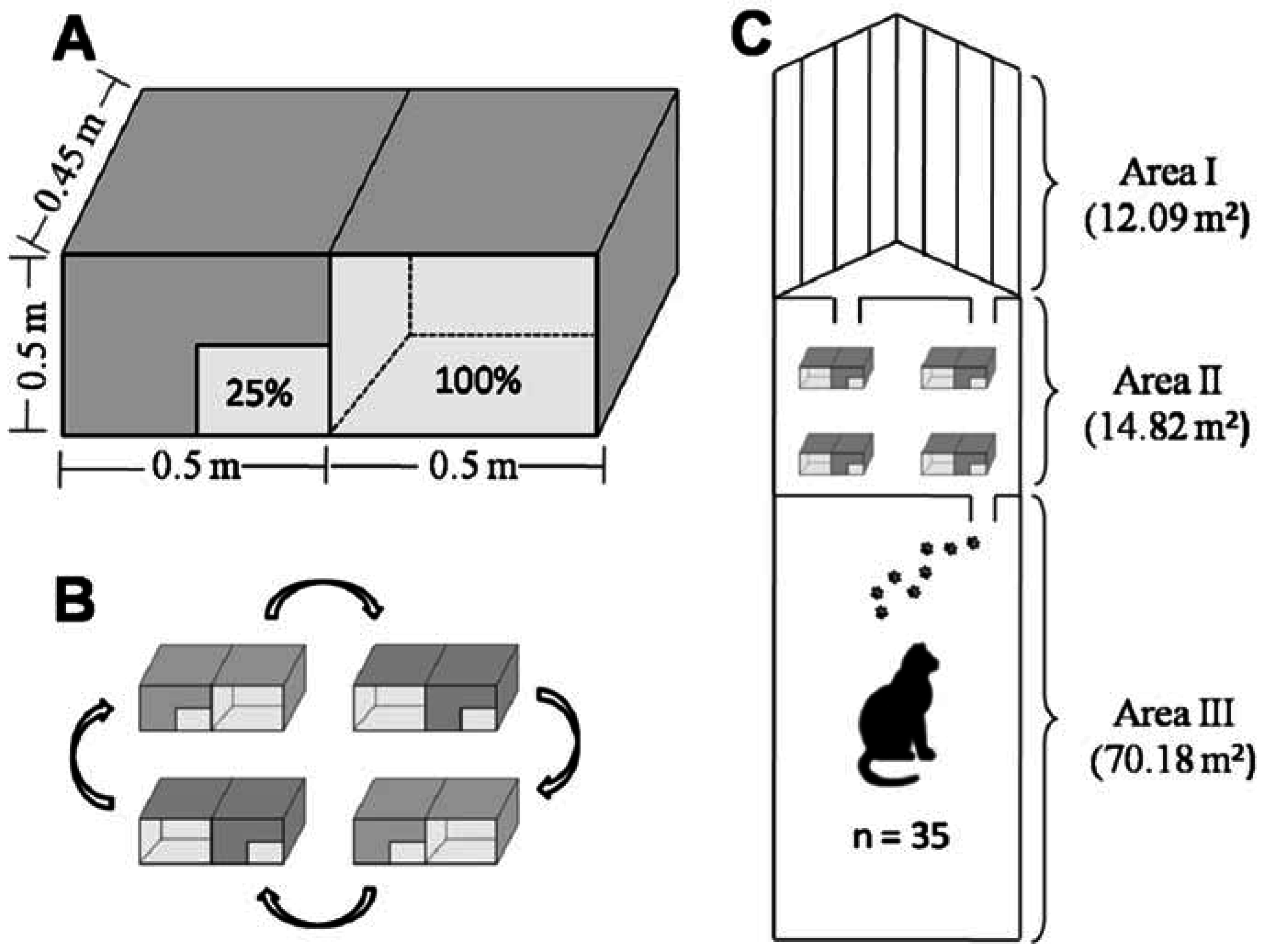
2.1. Experimental Protocol
2.1.1. Experiment I: Use of Horizontal Space
2.1.2. Experiment II: Enrichment of the Vertical Space
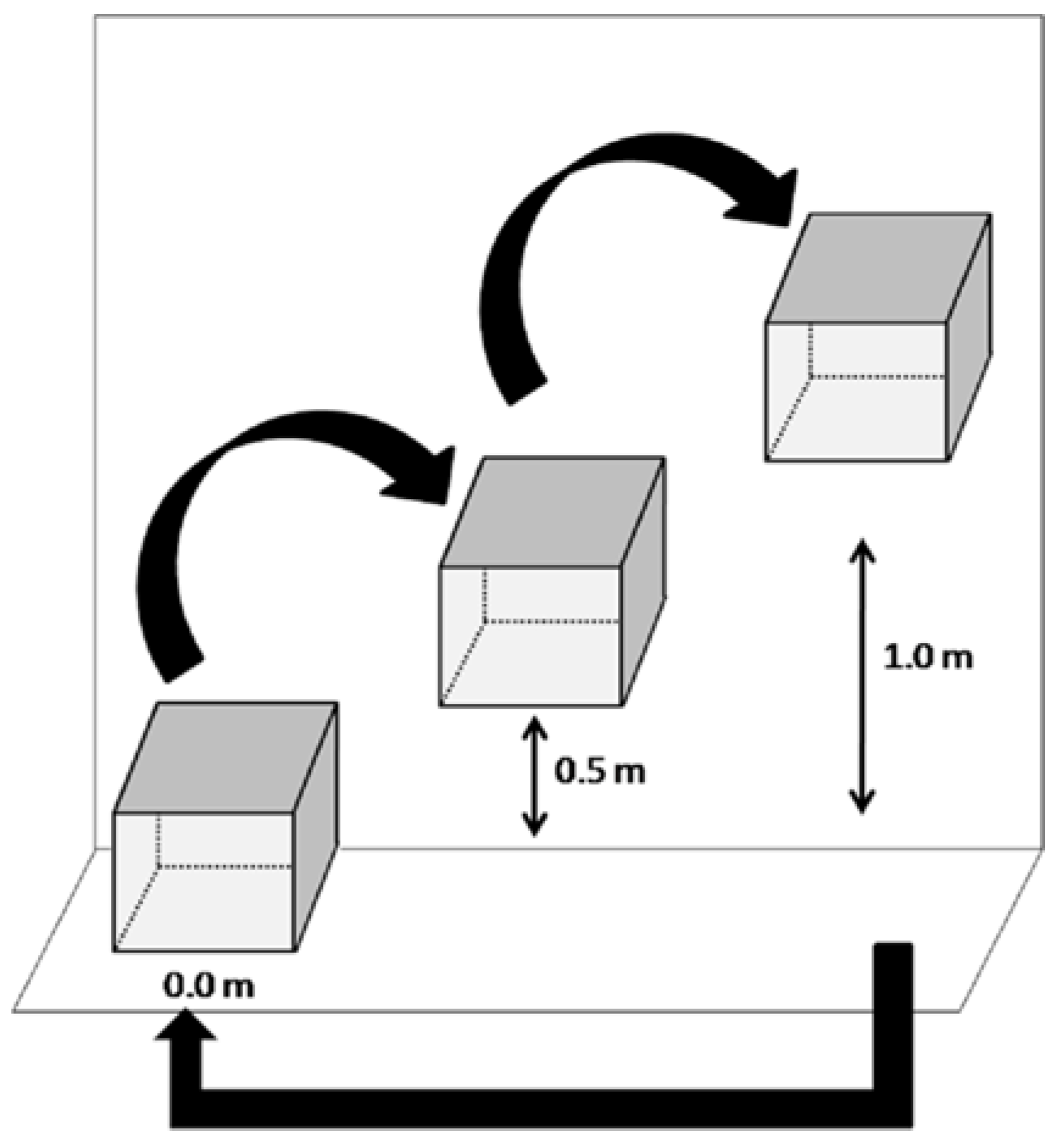
2.2. Data and Statistical Analysis
2.2.1. Experiment I: Use of Horizontal Space
| Interaction with Refuges | Behavior Categories | |
|---|---|---|
| Active | Inactive | |
| Physical contact with refuges (inside, over or leaning against the refuge) | Locomotion | Lying down |
| Grooming | Sitting | |
| Surface exploring | Sleeping | |
| Scratching | Standing | |
| Rubbing | ||
| No physical contact with refuges | Locomotion | Lying down |
| Grooming | Sitting | |
| Sleeping | ||
| Standing | ||
2.2.2. Experiment II: Enrichment of the Vertical Space
3. Results
3.1. Experiment I: Use of Horizontal Space
3.1.1. Frequency of Space Utilization
 ), no contact with the enrichment (
), no contact with the enrichment (  ) and without enrichment (control) (
) and without enrichment (control) (  ).*p < 0.05.
).*p < 0.05.
 ), no contact with the enrichment (
), no contact with the enrichment (  ) and without enrichment (control) (
) and without enrichment (control) (  ).*p < 0.05.
).*p < 0.05.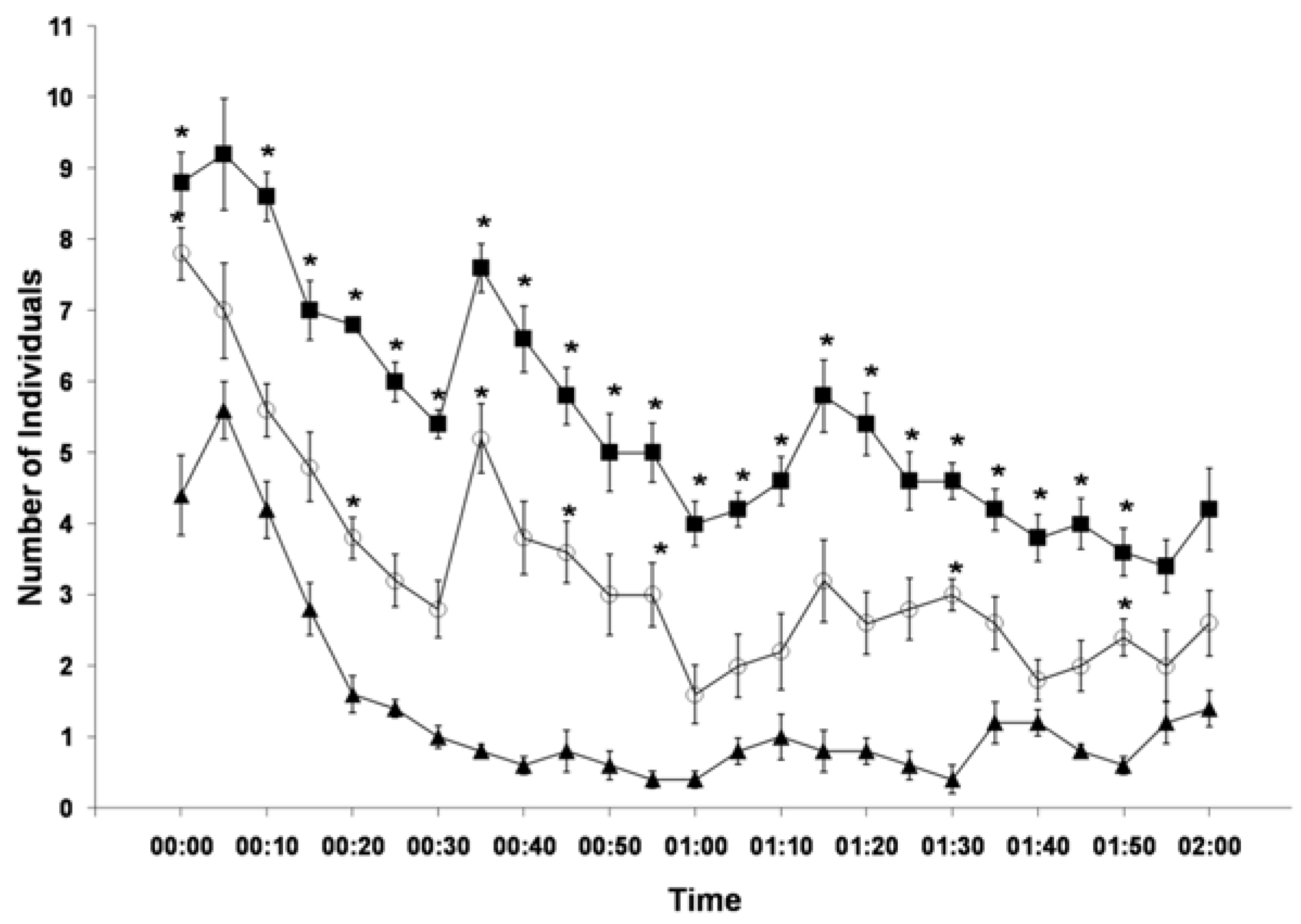
3.1.2. Frequencies of Active and Inactive Behaviors
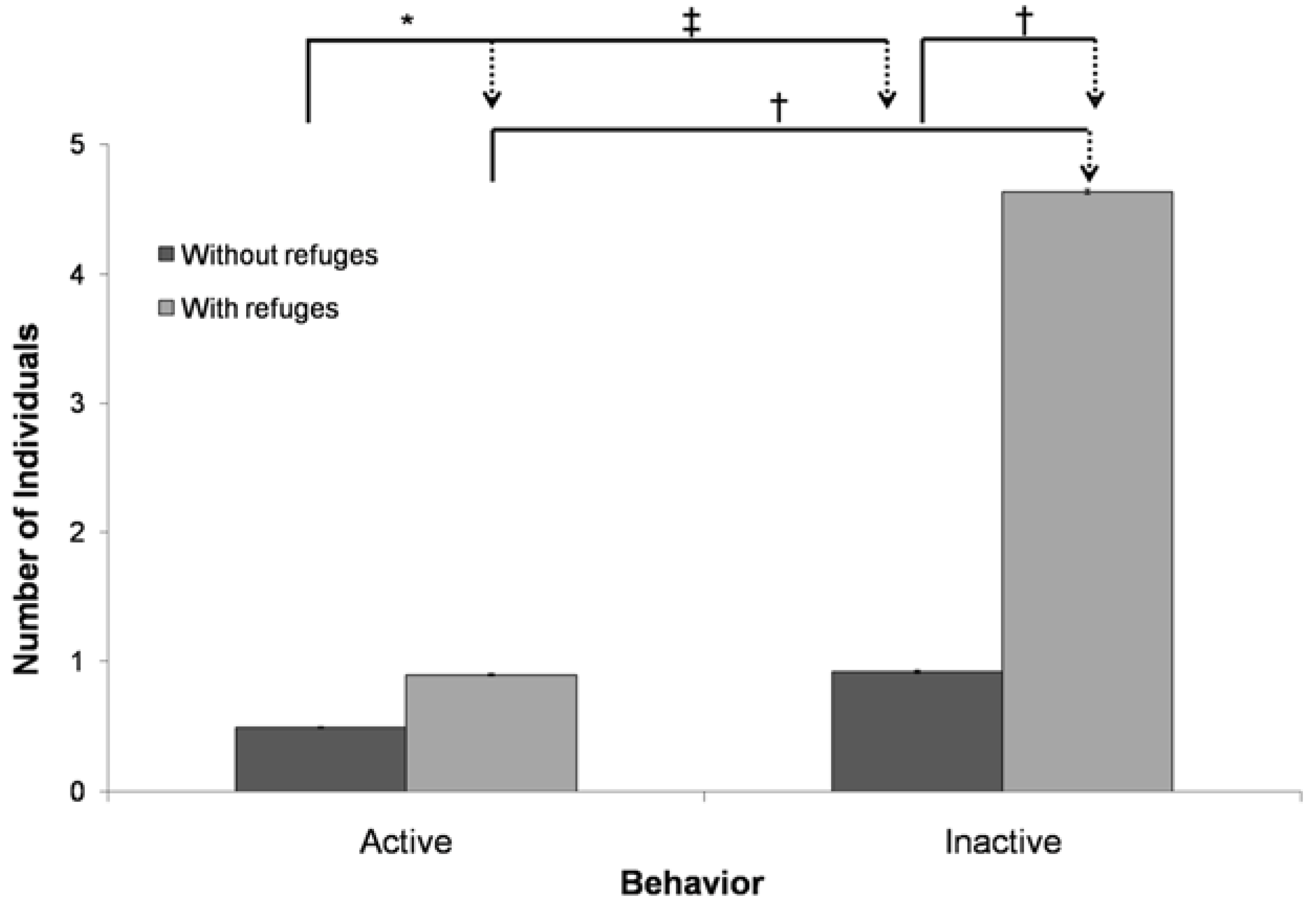
3.2. Experiment II: Enrichment of the Vertical Space
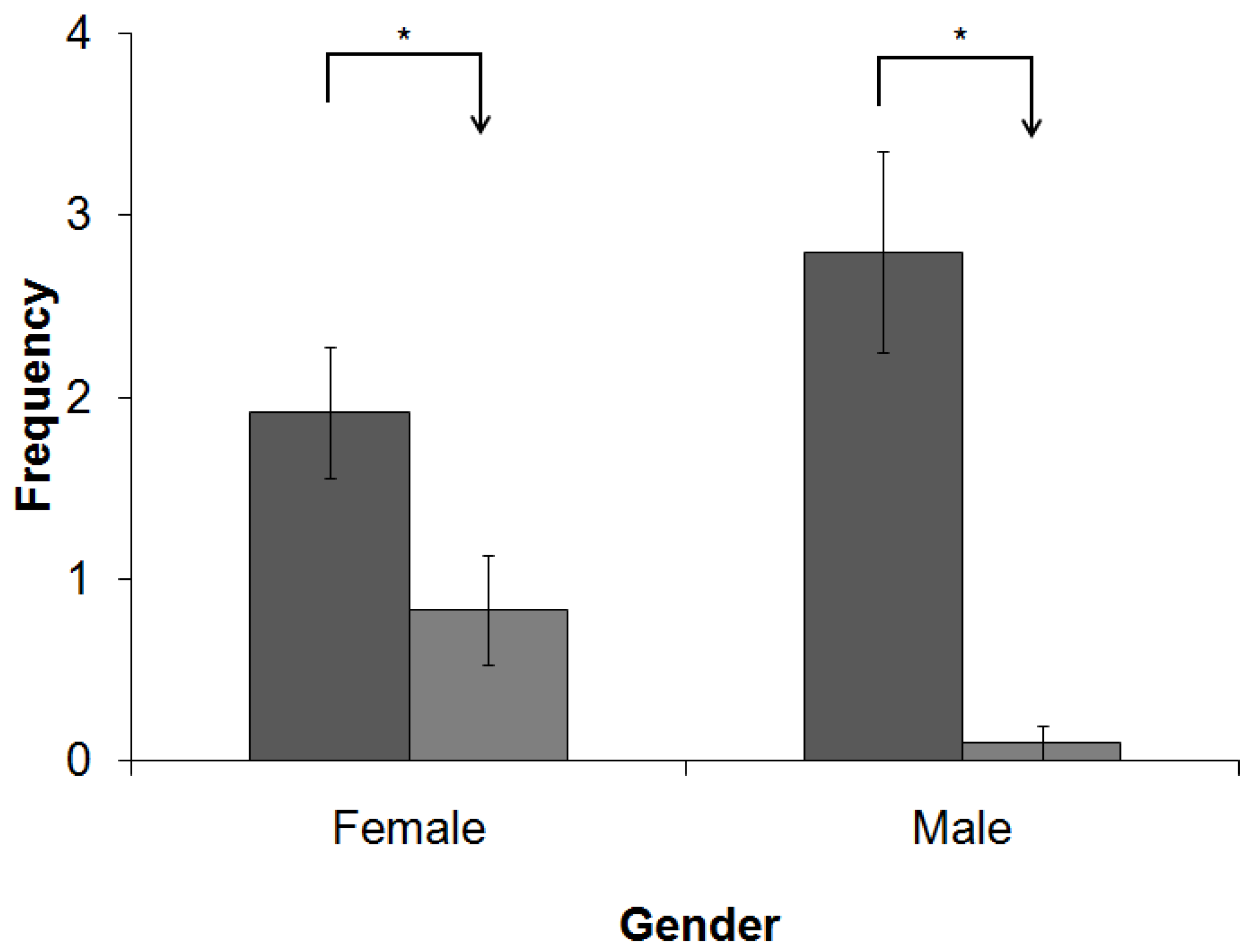
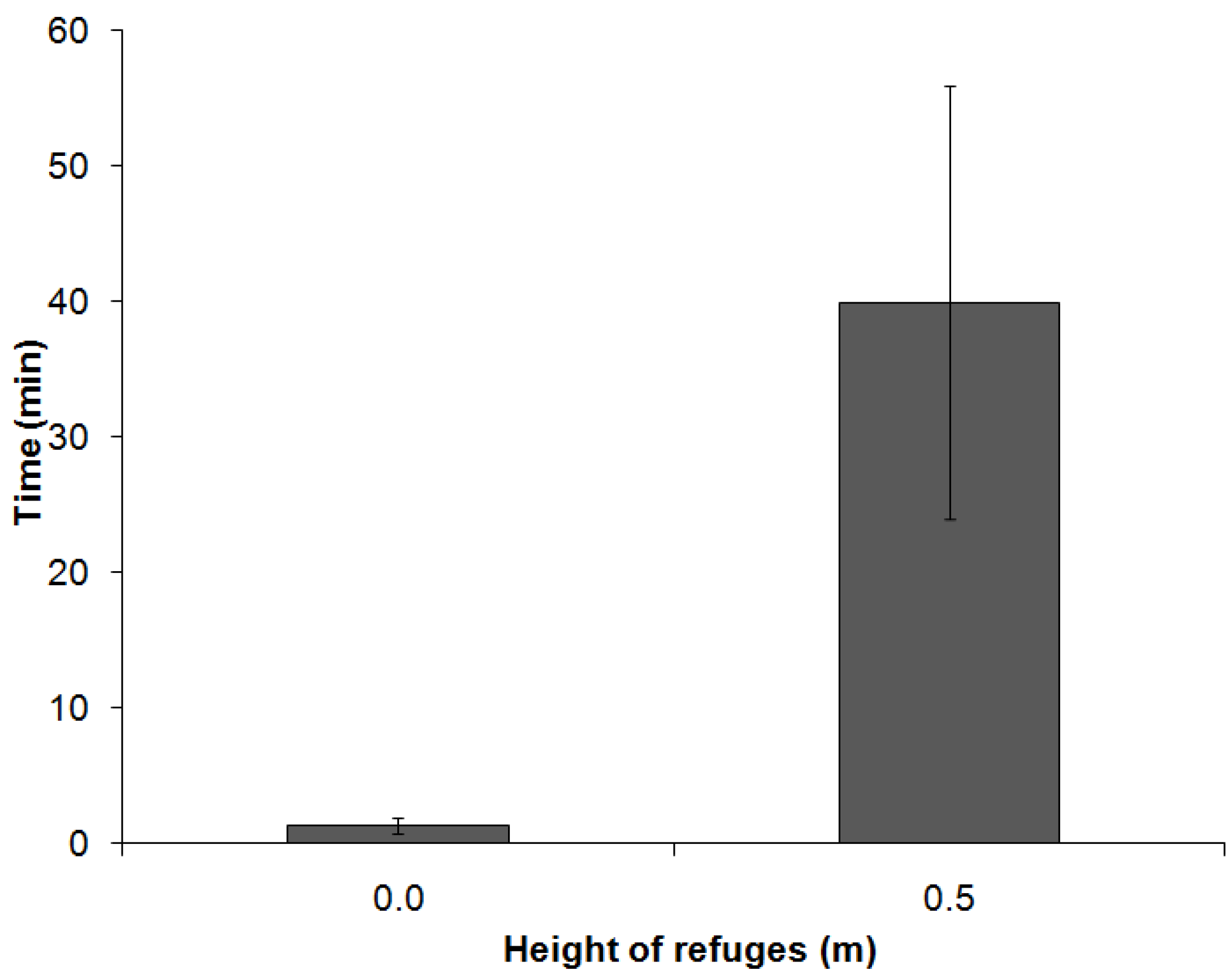
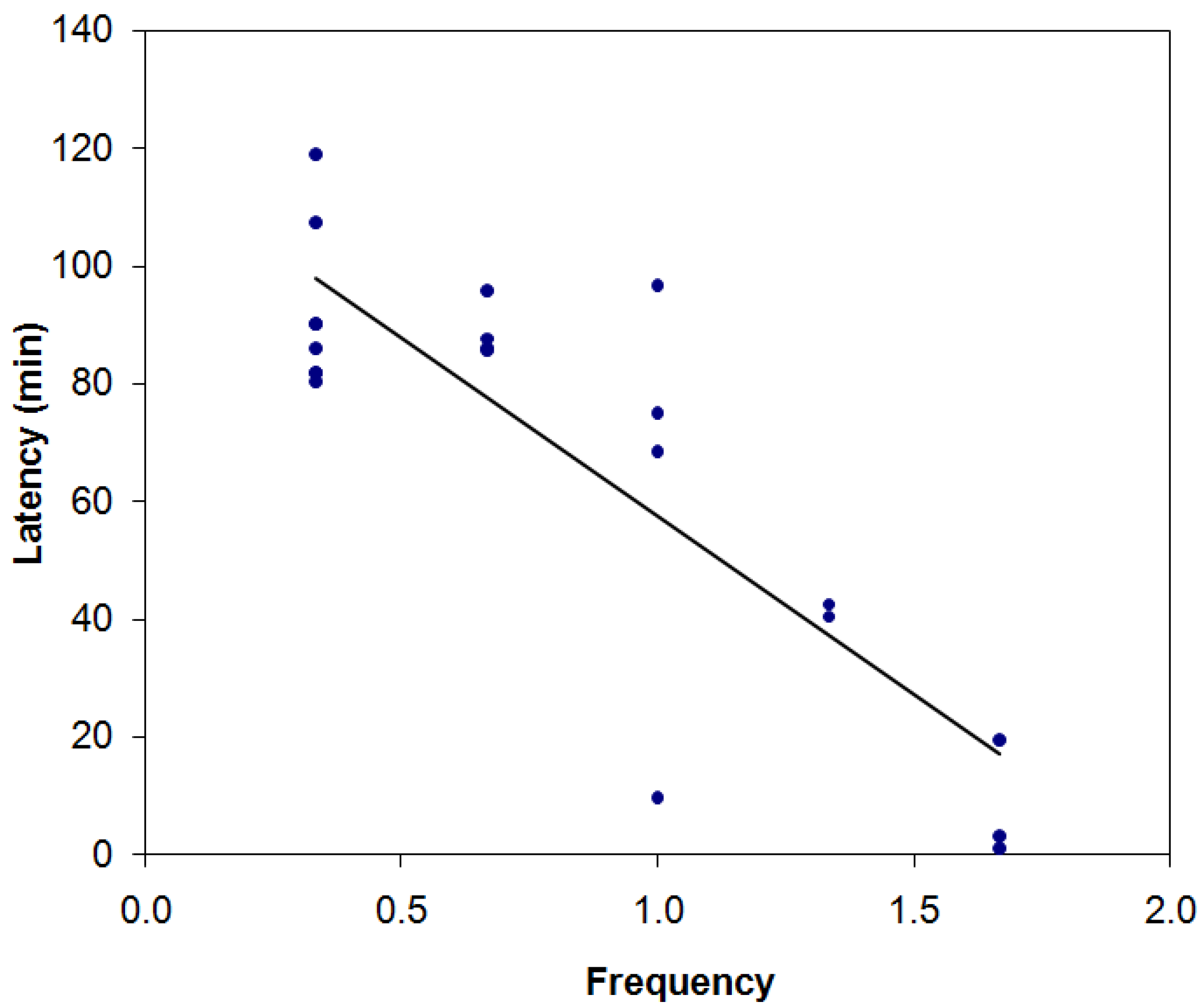
4. Discussion and Conclusions
4.1. Experiment I: Use of Horizontal Space
4.2. Experiment II: Enrichment of the Vertical Space
Acknowledgments
Author Contributions
Conflicts of interest
References
- Rochlitz, I. Housing and welfare. In The Welfare of Cats; Rochlitz, I., Ed.; Springer: Dordrecht, The Netherlands, 2005; pp. 177–203. [Google Scholar]
- Genaro, G. Domestic cat: Future challenge for the control of urban rabies? Pesqui. Vet. Bras. 2010, 2, 186–189. [Google Scholar] [CrossRef]
- Beaver, B.V. Comportamento felino: Um guia para veterinários. In Feline Behaviour: A Guide for Veterinarians, 2nd ed.; Roca: São Paulo, Brazil, 2005. [Google Scholar]
- Jongman, E.C. Adaptation of domestic cats to confinement. J. Vet. Behav. 2007, 2, 193–196. [Google Scholar] [CrossRef]
- Broom, D.M.; Fraser, A.F. Comportamento e bem-estar de animais domésticos. In Domestic Animal Behaviour and Welfare, 4th ed.; Manole: São Paulo, Brazil, 2010. [Google Scholar]
- Ross, S.R.; Schapiro, S.J.; Hau, J.; Lukas, K.E. Space use as an indicator of enclosure appropriateness: A novel measure of captive animal welfare. Appl. Anim. Behav. Sci. 2009, 121, 42–50. [Google Scholar] [CrossRef]
- Appleby, M.C.; Waran, N.K. Physical Conditions. In Animal Welfare; Appleby, M.C., Hughes, B.O., Eds.; CAB International Publications: Wallingford, UK, 1997; pp. 177–190. [Google Scholar]
- Barry, K.J.; Crowell-Davis, S.L. Gender differences in the social behaviour of the neutered indoor-only domestic cat. Appl. Anim. Behav. Sci. 1999, 64, 193–211. [Google Scholar] [CrossRef]
- Odendaal, J.S.J. Animal welfare in practice. Appl. Anim. Behav. Sci. 1998, 59, 93–99. [Google Scholar] [CrossRef]
- Genaro, G. Comportamentofelino: Organizacão social e spacial, comunicacão intra-específica e conflitos com a vida doméstica. Feline behaviour: Social and spatial organisation, intra-specific communication, and conflicts within domestic life. MEDVEP Rev. Cient. Med. Vet. Med. 2004, 2, 61–66. [Google Scholar]
- Weng, R.C.; Edwards, S.A.; English, P.R. Behaviour, social interactions and lesion scores of group-housed sows in relation to floor space allowance. Appl. Anim. Behav. Sci. 1998, 59, 307–316. [Google Scholar] [CrossRef]
- Hurley, K.F. Feline infectious disease control in shelters. Vet. Clin. N. Am. Small 2005, 35, 21–37. [Google Scholar] [CrossRef]
- Gourkow, N.; LaVoy, A.; Dean, G.A.; Phillips, C.J.C. Associations of behavior with secretory immunoglobulin A and cortisol in domestic cats during their first week in an animal shelter. Appl. Anim. Behav. Sci. 2014, 150, 55–64. [Google Scholar] [CrossRef]
- Rochlitz, I. A review of the housing requirements of domestic cats (Felis silvestri scatus) kept in the home. Appl. Anim. Behav. Sci. 2005, 93, 97–109. [Google Scholar] [CrossRef]
- Wemelsfelder, F. Life in captivity: Its lack of opportunities for variable behaviour. Appl. Anim. Behav. Sci. 1997, 54, 67–70. [Google Scholar] [CrossRef]
- Olsson, I.A.S.; Nevison, C.M.; Patterson-Kane, E.G.; Sherwin, C.M.; van de Weerd, H.A.; Würbel, H. Understanding behaviour: The relevance of ethological approaches in laboratory animal science. Appl. Anim. Behav. Sci. 2003, 81, 245–264. [Google Scholar] [CrossRef]
- Newberry, R.C. Environmental enrichment: Increasing the biological relevance of captive environments. Appl. Anim. Behav. Sci. 1995, 44, 229–243. [Google Scholar] [CrossRef]
- Mason, G.; Clubb, R.; Latham, N.; Vickery, S. Why and how should we use environmental enrichment to tackle stereotypic behaviour? Appl. Anim. Behav. Sci. 2007, 102, 163–188. [Google Scholar] [CrossRef]
- Holm, L.; Ladewig, J. The effect of housing rats in a stimulus rich versus stimulus poor environment on preference measured by sigmoid double demand curves. Appl. Anim. Behav. Sci. 2007, 107, 342–354. [Google Scholar] [CrossRef]
- Würbel, H.; Chapman, R.; Rutland, C. Effect of feed and environmental enrichment on development of stereotypic wire-gnawing in laboratory mice. Appl. Anim. Behav. Sci. 1998, 60, 69–81. [Google Scholar] [CrossRef]
- Sherwin, S.J.; Lewis, P.D.; Perry, G.C. The effects of environmental enrichment and intermittent lighting on the behaviour and welfare of male domestic turkeys. Appl. Anim. Behav. Sci. 1999, 62, 319–333. [Google Scholar] [CrossRef]
- Balcombe, J.P. Laboratory environments and rodents behavioural needs: A review. Lab. Anim. 2006, 40, 217–235. [Google Scholar] [CrossRef] [PubMed]
- Jensen, S.P.; Gray, S.J.; Hurst, J.L. How does habitat structure affect activity and use of space among house mice? Anim. Behav. 2002, 66, 239–250. [Google Scholar] [CrossRef]
- Cornetto, T.; Estevez, I. Influence of vertical panels on use of space by domestic fowl. Appl. Anim. Behav. Sci. 2001, 71, 141–153. [Google Scholar] [CrossRef] [PubMed]
- Kry, K.; Casey, R. The effect of hiding enrichment on stress levels and behaviour of domestic cats (Felis sylvestris catus) in a shelter setting and the implications for adoption potential. Anim. Welf. 2007, 16, 375–383. [Google Scholar]
- Rochlitz, I. Recommendations for the housing and care of domestic cats in laboratories. Lab. Anim. 2000, 34, 901–912. [Google Scholar] [CrossRef]
- Vinke, C.M.; Godijn, L.M.; van der Leij, W.J.R. Will a hiding box provide stress reduction for shelter cats? Appl. Anim. Behav. Sci. 2014, 160, 86–93. [Google Scholar] [CrossRef]
- Carlstead, K.; Brown, J.L.; Strawn, W. Behavioral and physiological correlates of stress in laboratory cats. Appl. Anim. Behav. Sci. 1993, 38, 143–158. [Google Scholar] [CrossRef]
- Kessler, M.R.; Turner, D.C. Stress and adaptation of cats (Felis silvestris catus) housed singly, in pairs and in groups in boarding catteries. Anim. Welf. 1997, 6, 243–254. [Google Scholar]
- Moore, A.M.; Bain, M.J. Evaluation of the addition of in-cage hiding structures and toys and timing of administration of behavioural assessments with newly relinquished shelter cats. J. Vet. Behav. 2013, 8, 450–457. [Google Scholar] [CrossRef]
- Dantas-Divers, L.M.S.; Crowell-Davis, S.L.; Alford, K.; Genaro, G.; D’Almeida, J.M.; Paixao, R.L. Agonistic behaviour and environmental enrichment of cats communally housed in a shelter. J. Am. Vet. Med. Assoc. 2011, 239, 796–802. [Google Scholar] [CrossRef] [PubMed]
- Triola, M.F. Essentials of Statistics, 3rd ed.; Pearson Addison Wesley: Boston, MA, USA, 2008. [Google Scholar]
- Gourkow, N.; Fraser, D. The effect of housing and handling practices on the welfare, behavior and selection of domestic cats (Felis sylvestris catus) by adopters in an animal shelter. Anim. Welf. 2006, 15, 371–377. [Google Scholar]
- Abou-Ismail, U.A.; Burman, O.H.P.; Nicol, C.J.; Mendl, M. The effects of enhancing cage complexity on the behaviour and welfare of laboratory rats. Behav. Process. 2010, 85, 172–180. [Google Scholar] [CrossRef]
- Genaro, G.; Schmidek, W.R. Exploratory activity of rats in three different environments. Ethology 2000, 106, 849–859. [Google Scholar] [CrossRef]
- Mellen, J.D.; Hayes, M.P.; Shepherdson, D.J. Captive environments for small felids. In Second Nature: Environmental Enrichment for Captive Animals; Shepherdson, D.J., Mellen, J.D., Hutchins, M., Eds.; Smithsonian Institution: Washington, DC, USA, 1998; pp. 184–201. [Google Scholar]
- Phillips, C.J.C.; Davies, E.; Lisle, A. Housing systems to meet the behavioural needs of a solitary mammal with an extensive home range: The Julia Creek dunnart (Sminthopsis douglasi). Appl. Anim. Behav. Sci. 2012, 141, 36–42. [Google Scholar] [CrossRef]
- Ventura, B.A.; Siewerdt, F.; Estevez, I. Access to barrier perches improves behaviour repertoire in broilers. PLoS ONE 2012, 7, e29826. [Google Scholar] [CrossRef] [PubMed]
- Rochlitz, I. Recommendations for the housing of cats in the home, in catteries and animal shelters, in laboratories and in veterinary surgeries. J. Feline Med. Surg. 1999, 1, 181–191. [Google Scholar] [CrossRef] [PubMed]
- Resende, L.S.; Gomes, K.C.P.; Andriolo, A.; Genaro, G.; Remy, G.L.; Ramos, V.D. Influence of cinnamon and catnip on the stereotypical pacing of Oncilla Cats (Leopardus tigrinus) in captivity. J. Appl. Anim. Welf. Sci. 2011, 14, 247–254. [Google Scholar] [CrossRef] [PubMed]
- Genaro, G.; Schmidek, W.R.; Franci, C.R. Social condition affects hormone secretion and exploratory behaviour in rats. Braz. J. Med. Biol. Res. 2004, 37, 833–840. [Google Scholar] [CrossRef] [PubMed]
- Dawkins, M.S. From an animal’s point of view: Motivation, fitness and animal welfare (with commentaries). Behav. Brain Sci. 1990, 13, 1–61. [Google Scholar] [CrossRef]
- Dawkins, M.S. Battery hens name their price: Consumer demand theory and the measurement of ethological “needs”. Anim. Behav. 1983, 31, 1195–1205. [Google Scholar] [CrossRef]
- Mendl, M.; Harcourt, R. Individuality in the domestic cats: Origins, development and stability. In The Domestic Cat: The Biology of Its Behaviour, 2nd ed.; Turner, D.C., Bateson, P., Eds.; Cambridge University Press: Cambridge, UK, 2000; pp. 47–64. [Google Scholar]
- Guy, J.H.; Meads, Z.A.; Shiel, R.S.; Edwards, S.A. The effect of combining different environmental enrichment materials on enrichment use by growing pigs. Appl. Anim. Behav. Sci. 2013, 144, 102–107. [Google Scholar] [CrossRef]
- Rosier, R.L.; Langkilde, T. Does environmental enrichment really matter? A case study using the eastern fence lizard, Sceloporus undulatus. Appl. Anim. Behav. Sci. 2013, 131, 71–76. [Google Scholar] [CrossRef]
© 2015 by the authors; licensee MDPI, Basel, Switzerland. This article is an open access article distributed under the terms and conditions of the Creative Commons Attribution license (http://creativecommons.org/licenses/by/4.0/).
Share and Cite
De Oliveira, A.S.; Terçariol, C.A.S.; Genaro, G. The Use of Refuges by Communally Housed Cats. Animals 2015, 5, 245-258. https://doi.org/10.3390/ani5020245
De Oliveira AS, Terçariol CAS, Genaro G. The Use of Refuges by Communally Housed Cats. Animals. 2015; 5(2):245-258. https://doi.org/10.3390/ani5020245
Chicago/Turabian StyleDe Oliveira, Adriana Sicuto, César Augusto Sangaletti Terçariol, and Gelson Genaro. 2015. "The Use of Refuges by Communally Housed Cats" Animals 5, no. 2: 245-258. https://doi.org/10.3390/ani5020245
APA StyleDe Oliveira, A. S., Terçariol, C. A. S., & Genaro, G. (2015). The Use of Refuges by Communally Housed Cats. Animals, 5(2), 245-258. https://doi.org/10.3390/ani5020245





